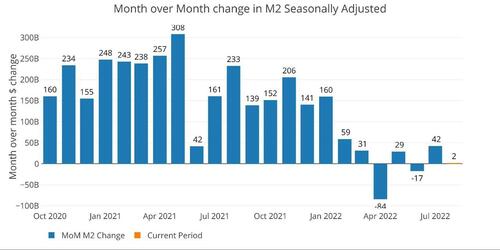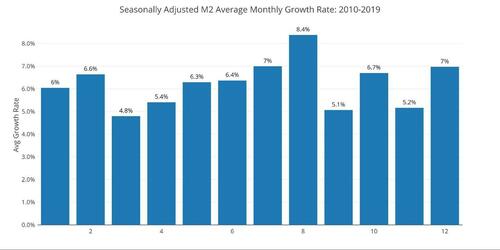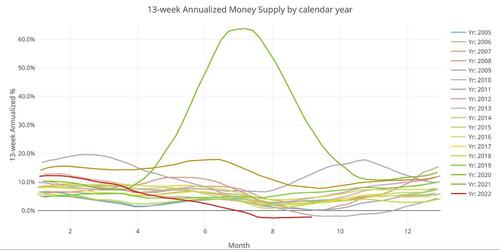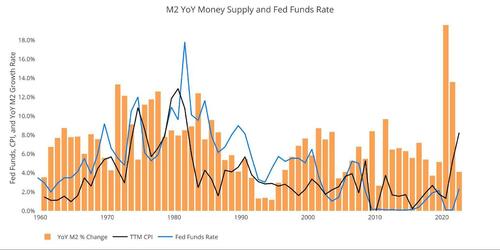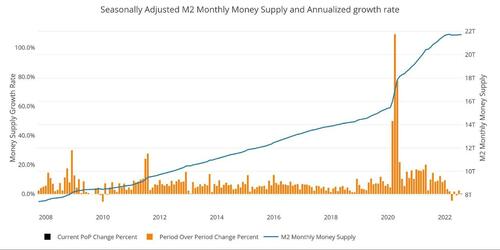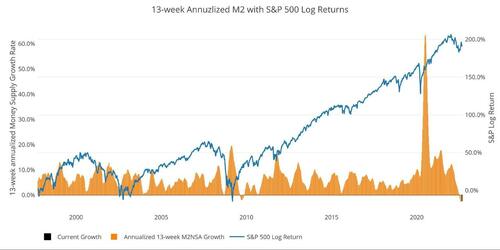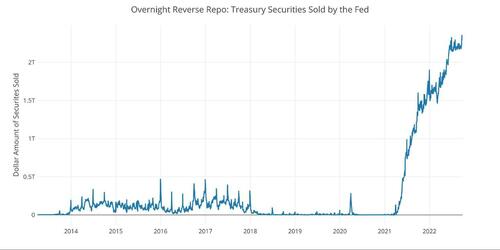Collapse In Money Supply Is Still A Major Risk For The Market
Money Supply growth was barely positive in August at $2B and sits well below the $233B seen last year. As the chart below shows, Money Supply growth has collapsed since February. Last year started with five straight months above $200B, whereas 2022 has only seen one month above $100B and that was January.
Figure: 1 MoM M2 Change (Seasonally Adjusted)
Figure 2 below shows the non-seasonally adjusted money supply which is a bit more erratic. Even with the increased volatility, it is very clear that there is far more weakness in the Money Supply in recent months. From this view, August was the strongest month since March but is still very slow.
Figure: 2 MoM M2 Change (Non-Seasonally Adjusted)
The latest month is actually slightly above the 6-month average growth rate (0.1% vs 0%). This is still way below the 1-year growth rate of 4.1% and well below the three-year annualized growth rate of 13.3%.
Figure: 3 M2 Growth Rates
When looking at the average monthly growth rate, before Covid, August historically expands at an annualized 8.4%, the highest month of the year. This year looks anemic by comparison.
Figure: 4 Average Monthly Growth Rates
The Fed only offers weekly data that is not seasonally adjusted. As the chart below shows, we have been seeing more frequent weeks of negative growth. It was only the latest week that drove the month to be positive.
Figure: 5 WoW M2 Change
The “Wenzel” 13-week Money Supply
The late Robert Wenzel of Economic Policy Journal used a modified calculation to track Money Supply. He used a trailing 13-week average growth rate annualized as defined in his book The Fed Flunks. He specifically used the weekly data that was not seasonally adjusted. His analogy was that in order to know what to wear outside, he wants to know the current weather, not temperatures that have been averaged throughout the year.
The objective of the 13-week average is to smooth some of the choppy data without bringing in too much history that could blind someone from seeing what’s in front of them. The 13-week average growth rate can be seen in the table below. Decelerating trends are in red and accelerating trends in green.
Growth has now collapsed to -2.23%. Ironically, the trend is currently moving up from the -2.57% seen 4 weeks ago. That had been the lowest reading since April 1993. The string of consecutive negative or zero growth in Money Supply ended at 29 weeks. That being said money supply growth is still negative.
Figure: 6 WoW Trailing 13-week Average Money Supply Growth
The plot below helps show the seasonality of the Money Supply and compares the current year (red line) to previous years. For the months of August and September, this is the slowest 13-week Money Supply growth ever recorded.
The chart below goes back to 2005 and the current growth rate is below every single period on the chart and below any other data point for this time of year, even edging out 2009 (-2.2% vs -1.7% back then).
Wenzel often commented on his ability to guess the timing of the 2008 stock market crash based on the Money Supply that year falling from 11.6% to 0% in a matter of months. In 2022, growth has slowed from 12.2% to -2.27% in less than 6 months. Not to mention the collapse from 64% seen in 2020.
More importantly, is that it’s not picking back up. It’s moved up a bit from the August lows, but it’s still negative! This is a major slowdown in Money Supply and could pose significant headwinds for the stock market and economy.
Figure: 7 Yearly 13-week Overlay
Behind the Inflation Curve
To combat rising prices, the Fed would need to undo most of the money it has created over the last several years. This would require bringing interest rates above the rate of inflation.
The Fed has been talking a huge game, but everyone should know they are bluffing! They can’t actually raise rates or they would have by now! The chart below shows that the Fed has never been further behind the inflation curve despite the “jumbo” interest rate hikes seen so far.
The blue line below (Fed Funds Rate) has almost always gotten above the black line (CPI) to force inflation back down. The one anomaly was in 2011 after the Great Recession. The mainstream is now assuming this is the norm (i.e., a recession alone will slow inflation), but the chart below shows that it’s far more common that interest rates must exceed inflation to bend the curve back down. The recent period has made the Fed complacent. This is very dangerous!
Figure: 8 YoY M2 Change with CPI and Fed Funds
Historical Perspective
The charts below are designed to put the current trends into a historical perspective. The orange bars represent annualized percentage change rather than the raw dollar amount. The current slowdown can be seen on the right side.
If a few months of M2 slowdown can cause this much pain across the economy (stock market, real estate, bond yields, etc.), how much carnage would unfold in a prolonged fight against inflation where M2 had to shrink consistently for months?
Figure: 9 M2 with Growth Rate
Taking a historical look at the 13-week annualized average also shows the current predicament. This chart overlays the log return of the S&P. Mr. Wenzel proposed that large drops in Money Supply could be a sign of stock market pullbacks. His theory, derived from Murray Rothbard, states that when the market experiences a shrinking growth rate of Money Supply (or even negative) it can create liquidity issues in the stock market, leading to a sell-off.
While not a perfect predictive tool, many of the dips in Money Supply precede market dips. Specifically, the major dips in 2002 and 2008 from +10% down to 0%. The economy is now grappling with a peak growth rate of 63.7% in July 2020 down to -2.25%. This is a major collapse.
The market finally got a rebound off the summer lows, but that is looking like a dead cat bounce. The chart below shows that a full market collapse cannot be ruled out!
Please note the chart only shows market data through September 5 to align with available M2 data.
Figure: 10 13-week M2 Annualized and S&P 500
One other consideration is the massive liquidity buildup in the system. The Fed offers Reverse Repurchase Agreements (reverse repos). This is a tool that allows financial institutions to swap cash for instruments on the Fed balance sheet.
Current Reverse Repo are now approaching $2.5T with $2.35T recorded as of Sept 22. The value always tops out at quarter end so there should be a new peak on Friday. These numbers dwarf the old record of ~$500B in 2016-2017.
Bottom line, even though M2 has slowed there is still trillions of dollars in liquidity sloshing around. New money will not be available to prop up the stock market, but excess liquidity is still available to bid up prices and keep inflation elevated.
Figure: 11 Fed Reverse Repurchase Agreements
What it means for Gold and Silver
The market is currently experiencing an epic collapse in the Money Supply growth rate. Based on historical data, August is typically when Money Supply growth reaches the bottom. However, the increase seen so far in September has been anemic at best.
The Fed is playing with serious fire. They are raising rates and crashing the money supply, but they have not come close to undoing all the damage done in 2020 and 2021 (much less the last decade). They are going to break something very soon and then what? There is still too much money circulating to bring down inflation.
When something breaks the Fed will pivot and step in. They won’t stand by and watch the global economy explode. When they pivot and inflation is still well north of 2%, gold and silver could take off like a Rocketship.
Tyler Durden
Sat, 10/01/2022 – 10:30
via ZeroHedge News https://ift.tt/kwnZKeR Tyler Durden
